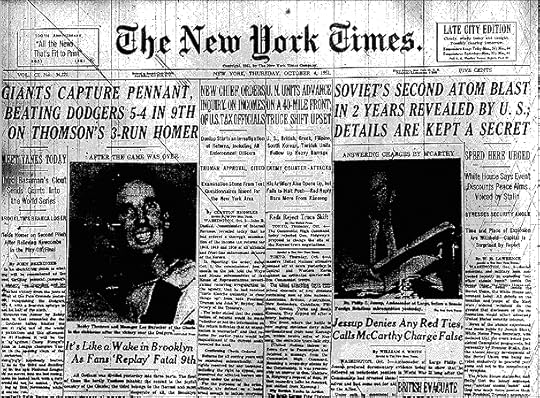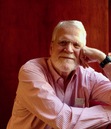Mark Scott Smith's Blog: Enemy in the Mirror, page 52
November 12, 2020
USSR Acknowledges It Has Atomic Bomb
After the atomic bombings of Hiroshima and Nagasaki, the USSR utilized intelligence gathered from the German nuclear weapons project and the American Manhattan Project to aggressively pursue the development of a Russian atomic bomb.
In August 1949, the Soviet Union secretly conducted its first successful weapon test

Although President Harry Truman announced in September 1949, that there had been an atomic explosion in Russia, he did not say specifically that it was an atom bomb that had been exploded.
In October 1951 Josef Stalin acknowledged that the USSR had an atomic bomb

The post USSR Acknowledges It Has Atomic Bomb appeared first on Enemy in the Mirror.
November 11, 2020
Veterans Day
 PixaBay
PixaBay
I am grateful to all our men and women who have served in wartime. I am also sorrowed by the loss of so many.
 Wikipedia
Wikipedia Picryl
Picryl
The moon gives you light,
And the bugles and the drums give you music,
And my heart, O my soldiers, my veterans,
My heart gives you love.
~ excerpt from Walt Whitman Dirge for two veterans
The post Veterans Day appeared first on Enemy in the Mirror.
November 9, 2020
An American in Paris
An American in Paris was a 1951 American musical comedy inspired by the 1928 orchestral composition An American in Paris by George Gershwin. The film starred Gene Kelly, Leslie Caron, Oscar Levant, Georges Guétary and Nina Foch,
Popular songs in the movie included I Got Rhythm, Love Is Here to Stay, I’ll Build A Stairway to Paradise and S Wonderful.
The climax of the film was a 17-minute dialogue-free dance featuring Kelly and Caron.
An American in Paris won six Academy Awards including Best Picture in 1952.
The post An American in Paris appeared first on Enemy in the Mirror.
November 5, 2020
Radio Moscow
Radio Moscow’s interval signal.
Radio Moscow (Pадио Москва) was the official international broadcasting station of the Union of Soviet Socialist Republics until 1993.
After the fall of the Soviet Union It was reorganized with a new name: Voice of Russia, which has also since been reorganized and renamed Radio Sputnik.
At its peak, Radio Moscow broadcast in over 70 languages using transmitters in the Soviet Union, Eastern Europe, and Cuba.

The post Radio Moscow appeared first on Enemy in the Mirror.
November 2, 2020
Chinese People’s Liberation Army Attack
I have been researching this topic for a historical novel I am writing about the Korean War. This video clip is not representative of Chinese attacks in the Korean War—People’s Liberation Army attacks were typically carried out by smaller attack teams concentrating on a particular enemy line of defense.
Quite familiar to most Americans, human wave Banzai charges were used in the Pacific War WWII by the Imperial Japanese Army. During the Chinese Civil War, Nationalist Chinese accused the Chinese People’s Liberation Army (PLA) of using unarmed civilians as human shields in human sea attacks to drain Nationalist ammunition during battles.
Although attacks by the People’s Liberation Army troops during the Korean War have often been depicted in the West as human wave attacks, they are more properly described as Chinese short attacks— a combination of infiltration and shock tactics in which the Chinese assault team would crawl undetected within hand grenade range, then launch surprise attacks to breach the defenses by relying on maximum shock and confusion.
 automototale.com
automototale.comUsually carried out at night, Chinese short attacks, announced by an eerie cacophony of bugles, whistles, drums and cymbals, thrust small fire teams on a narrow front against the weakest point in enemy defenses. If the initial shock failed to breach the defenses, additional fire teams would attack the same point until penetration was achieved. Then the bulk of the Chinese forces would attack the enemy from behind.
Masked in the terrain, Chinese short attacks were carefully timed to minimize casualties and often repeated indefinitely until either the defenses were penetrated or the attacker’s ammunition supply was exhausted, regardless of the chances of success or human cost.
Main Source: Wikipedia
_________________________
At 2200, a red flare rose above the high ground to the east. Then, with a whistle blast, a company-sized unit of PLA charged the perimeter of RCT-31. With clanging cymbals and bugle calls, the Chinese infantrymen shrieked something that, to Nick, sounded like “you die!”
Red and green tracers arced back and forth as machine gun bullets and mortar shells streaked through the bluish-white light of the star shells slowly parachuting down over the frozen hillside. White-quilted soldiers, firing burp guns and flinging fragmentation hand grenades, rushed into the perimeter of Able Company.
Crouching behind the log barrier, Nick fired his M1 carbine as fast as he could. But the PLA kept charging—farmers and peasants leaping like Kung Fu fighters over the bodies of their fallen comrades. They were almost on top of Nick. Was this the end?– Excerpt from my upcoming historical fiction novel about events leading up to the battle of Chosin Reservoir
The post Chinese People’s Liberation Army Attack appeared first on Enemy in the Mirror.
October 31, 2020
Halloween Trick or Treat 1951
October 29, 2020
Armed Forces Radio Service
After WWII, the Armed Forces Radio Service (AFRS) employed mobile radio vans and commandeered Japanese stations on the mainland, Korea, the Marianas, and the Ryukyus.
After the Korean War broke out, broadcasts to Korea from Japan were transmitted from the Far East Network (FEN) headquarters in the Radio Tokyo building.
The post Armed Forces Radio Service appeared first on Enemy in the Mirror.
October 26, 2020
Man from Planet X, The Thing & Day the Earth Stood Still
Meanwhile, on the home front the public was fascinated by outer space.
The post Man from Planet X, The Thing & Day the Earth Stood Still appeared first on Enemy in the Mirror.
October 22, 2020
Battles of Bloody Ridge and Heartbreak Ridge
By the summer of 1951, the Korean War had reached a stalemate a few miles north of the 38th parallel where UN and Communist forces clashed in several relatively small but bloody battles.
The Battle of Bloody Ridge from mid-August to early September 1951 was an attempt by American and Republic of Korea (ROK) forces to seize a ridge a few miles north of the 38th parallel that was being used by the North Korean People’s Army (NKPA) as an observation post to call in artillery fire on a UN supply road. After a series of fierce hand-to-hand assaults and repulsions, the NKPA finally abandoned the hill. 2,700 UN and ~15,000 NKPA troops were killed or wounded with few prisoners taken by either side.
After withdrawing from Bloody Ridge, the NKPA set up new positions only ~1,500 yards away on a seven-mile-long hill that became known as Heartbreak Ridge. With intense attacks and counterattacks, the battle for Heartbreak Ridge from mid-September to mid-October 1951 proved even more difficult than that for Bloody Ridge.
“Battles begun by a bomb, bullet and shell were inevitably finished by grenade, trench knife and fists as formal military engagements degenerated into desperate hand-to-hand brawls...” – The Battle of Heartbreak Ridge
With continual NKPA reinforcements and resupply, it became clear that repeated UN infantry assaults on the ridge would not succeed. A new UN plan was devised to cut the ridge off from further reinforcement. On October 11th, with >30 tanks, artillery and airplane support, the UN 2nd Division attacked the ridge just as the Chinese 204th Division was moving up to relieve the NKPA. The Chinese division suffered heavy casualties but managed to damage five Sherman tanks before the Americans halted the offensive.
On October 12, with reinforced anti-tank trenches and a battalion of anti-tank guns, Chinese forces halted a UN attack, destroying or damaging 18 tanks. Subsequent battles were extremely brutal and costly.
After 30 days of combat, American and French forces eventually secured Heartbreak Ridge. But with 38 armored vehicles destroyed and nine damaged, UN forces did not penetrate the valley to reach the town of Mundung-ni. The defense of the Mundung-ni Valley is now celebrated in North Korea as the victorious battle of Height 1211
With the loss of >3,700 American and French and an estimated 25,000 North Korean and Chinese casualties, the UN command decided that battles like Heartbreak Ridge were not worth the high cost in blood for the relatively small amount of terrain captured.
 Pinterest
Pinterest
1986 movie
The post Battles of Bloody Ridge and Heartbreak Ridge appeared first on Enemy in the Mirror.
October 19, 2020
Dragnet – Danger Ahead
Dun Da dun dun ~ Walter Schumann‘s ominous, four-note introduction to the TV show Dragnet was recognized by most Americans in the 1950s to signify “danger ahead.”
Dragnet was an American television series, based on the radio series of the same name, both created by Jack Webb.
Webb played the Los Angeles police detective Sergeant Joe Friday. Ben Alexander co-starred as Friday’s partner, Officer Frank Smith.
The police term Dragnet describes coordinated measures for apprehending suspects, including road barricades and traffic stops, DNA tests, and general increased police alertness. The term is derived from dragging a fishing net across the bottom or through a promising area of open water.
The post Dragnet – Danger Ahead appeared first on Enemy in the Mirror.
Enemy in the Mirror
I began by posting events around the turn This website www.enemyinmirror.com explores the consciousness, diplomacy, emotion, prejudice and psychology of 20th Century America and her enemies in wartime.
I began by posting events around the turn of the 20th century as I was researching my first novel about the Pacific War. I continued through WWII for my second novel about the Battle of the Atlantic. Now I am beginning to look at the Cold War as I gather information for my next novel about the Korean War. ...more
- Mark Scott Smith's profile
- 7 followers




